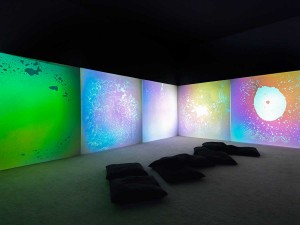“So, it’s, um, auto-destructivist art. A creative form of political protest through destruction and disintegration”.
Such were my words in an attempt to convince my family to come to the new exhibition at Kettle’s Yard, ‘Lift Off!’, featuring the work by the activist and artist Gustav Metzger. This rather paltry attempt to enthuse was fairly unsuccessful, and it was a sullen group that shuffled into the extension of Jim Ede’s bequeathed house. I needn’t have worried, however. Twenty minutes later we were all lying on the floor in awed silence, transfixed by a particular piece entitled ‘Liquid Crystal Environment’.
In it, this all absorbing and all encompassing rapture, slides containing heat sensitive liquid crystals are rotated, creating movement that is projected onto the walls. As they are heated and cooled the crystals also change colour, creating a protozoic psychedelia. The wish emblazoned on the wall in the previous room suddenly became manifest; that Metzger wanted art that would “levitate”, art that would “gyrate”. Faced with these endlessly moving shapes, his wish was transparent. Removed from the acts of human and consciously physical creation, a new type of artistic distance is created. But did this distance permit greater comprehension?
In ‘Liquid Crystal Environment’ politics, an element so strong in Metzger’s writings, did not seem to me to be a primary concern. Or certainly it inspired no political anxiety within me. Rather a state of abstract being. It was like lying back and looking at the stars, whilst the immediate present remained irrelevant. The forms were histological, although it was not they that changed but rather their colour and luminosity. Eventually, their flickering grew stronger, more urgent. Saturation increased with violent luminosity until it was almost painful to look at them. But, as if in a trance, everyone in the room stayed. The light became blinding, and reality became the vision you get when you shut your eyes after too much brightness. And then, popping in and in with less confidence and determination each time, the forms slowly faded to black.
This spectacle required no artistic foreknowledge or understanding. Simply every human’s deep attraction to light. And there was a certain beauty in that, one quite different to many of Metzger’s other works, such as ‘Dancing Tubes’. Without the choice sentences from his fifth manifesto (a nice curatorial choice) the work would have been totally baffling. Every ten minutes, two tubes… well, dance. All very interesting, but what of it? The words of Metzger must be turned to, in particular his notions regarding random activity. Art, he says, is the “drawing of belief”, whilst random activity “escalates an extension of accepted (unproductive) concepts of art, nature and society”. The presentation of activity with the minimal amount of interruption by the artist is “belief at its maximum’. So random activity allows the work to take on a new state, to reach a particular “transcendence…which the artist could not achieve except through random activity”. A perfectly logical explanation to the seeming chaos of the work.
Metzger’s work is exciting and inspiring. His works combined with his words force you to think about the implications of technology, the effect of machines and the social responsibility of the artist. What is interesting is that he uses this problematic technology in his art, and in so doing creates things which are profoundly beautiful. It’s a pity that the exhibition is so small, but it leaves you with that delicious feeling of wanting more.
Gustav Metzger: Lift Off continues at Kettle’s Yard, Cambridge until 31 August 2014.



